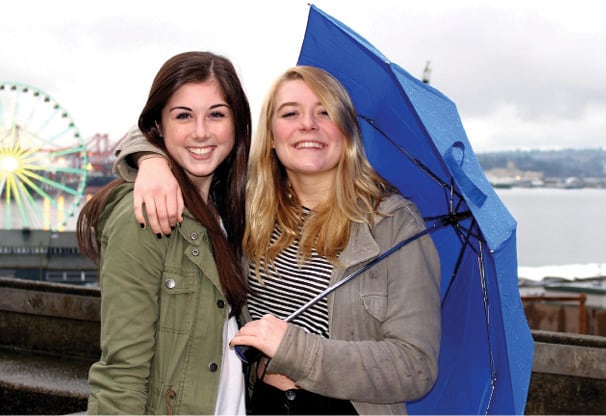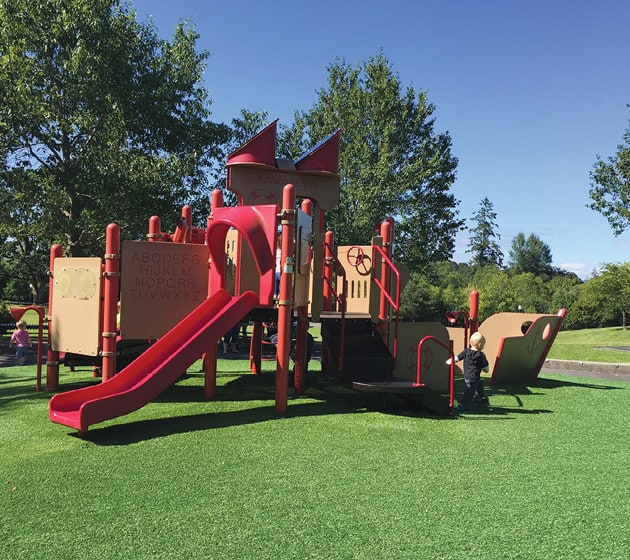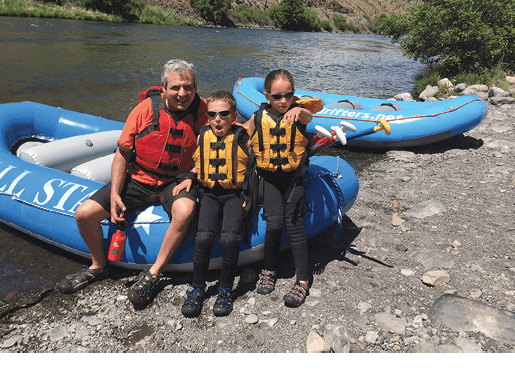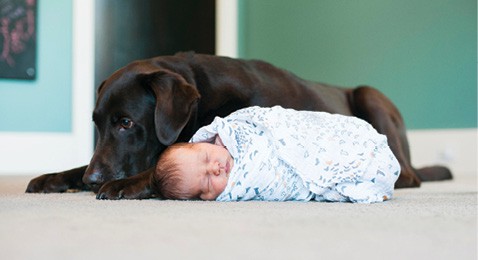Straight talk on redshirting for kindergarten, the best family bug sprays and our top picks for destination playgrounds.
Kids to Know: Drama Queens
Getaway: Maupin
TOP 5 . . . Destination Playgrounds
Bookshelf: Drop Everything and Read
Gear Guide: Fight Bug Bites
Pro-Tips: Pet Meets Baby
Good Deeds: Feed a Neighbor
Chalkboard: Baby Blues
We Recommend
Ask Dr. Corey
Kids to Know: Drama Queens
 The theater has a played a pivotal part in the lives of 17-year-old high school students Gracie Jacobson (pictured right) and Jordyn Mayer (pictured left). And the duo wanted to share their love of the arts with children who may not normally get involved with the theater. “Two years ago Gracie came to me with the idea to do a summer theater camp and asked if I wanted to create it with her,” says Mayer “We decided we wanted to reach out to children in the foster care system and build our camp specifically for them.” “We discovered that most camps catered toward foster children have a focus on sports,” adds Jacobson. “This helped us realize that our camp could be something unique.” Jacobson, a senior at Wilson High, is a veteran actor with Oregon Children’s Theatre and Northwest Children’s Theater. Mayer, a senior at Jesuit High School, loves the behind-the-scenes work of costume and set design. The pair enlisted several working professionals to help their idea come to fruition, including Michael Mayer, Jordyn’s uncle, who is a production designer for television shows including Judging Amy and Bones. Jacobson and Mayer will launch Discover Theatre Camp August 1 to 5 for foster kids in first through eighth grades. Camp participants will learn a song, a choreographed dance and a scene they will showcase at the end of the week. Students also have the chance to create their own sets and costumes as well as learn improvisation games, and acting and singing techniques. The cost is $25 for the full week and scholarships are available. For more information visit: discovertheatre.org.
The theater has a played a pivotal part in the lives of 17-year-old high school students Gracie Jacobson (pictured right) and Jordyn Mayer (pictured left). And the duo wanted to share their love of the arts with children who may not normally get involved with the theater. “Two years ago Gracie came to me with the idea to do a summer theater camp and asked if I wanted to create it with her,” says Mayer “We decided we wanted to reach out to children in the foster care system and build our camp specifically for them.” “We discovered that most camps catered toward foster children have a focus on sports,” adds Jacobson. “This helped us realize that our camp could be something unique.” Jacobson, a senior at Wilson High, is a veteran actor with Oregon Children’s Theatre and Northwest Children’s Theater. Mayer, a senior at Jesuit High School, loves the behind-the-scenes work of costume and set design. The pair enlisted several working professionals to help their idea come to fruition, including Michael Mayer, Jordyn’s uncle, who is a production designer for television shows including Judging Amy and Bones. Jacobson and Mayer will launch Discover Theatre Camp August 1 to 5 for foster kids in first through eighth grades. Camp participants will learn a song, a choreographed dance and a scene they will showcase at the end of the week. Students also have the chance to create their own sets and costumes as well as learn improvisation games, and acting and singing techniques. The cost is $25 for the full week and scholarships are available. For more information visit: discovertheatre.org.
— Denise Castañon
Getaway: Maupin
Let’s be honest: There’s really only one reason to come to this friendly, sunbaked town in north-central Oregon –the mighty Deschutes River. We submit that in August, when the flows are low and the temperature is hot, there’s no better place in Oregon to introduce your kids to the joys of river rafting. (They’ll need to be at least 4 years old to go with a rafting company, though.) A scenic drive of about two and a quarter hours gets you there. Sign up in advance with one of the rafting outfits in town — we like All-Star and River Drifters — and settle in for a fun, splashy ride. The highlights are the swooping class-3 rapids known as Boxcar and Wapinitia. Brave older kiddos can “ride the bull,” perched astride the bow of the raft — but smaller kids will want to stick in the rear of the boat near your guide. Make sure to ask your guide to bring along some water guns so you can retaliate in kind if you get ambushed by other rafters, and be on the lookout for slower moving stretches of water where you can take a dip. You could make it a day trip, but we recommend staying the night at the Imperial River Company’s hotel, which has family-friendly connecting rooms, a huge grassy lawn that slopes down to the river, a fire pit for s’mores and a kid-pleasing menu.
— Julia Silverman
TOP 5 . . . Destination Playgrounds
1. Beaverton’s Bethany Meadows Park was so often called “Pirate Park” for its pirate ship playground structure that Tualatin Hills Parks & Rec finally changed the park’s name. Get there via NW Graf St. and NW Energia St.
2. The inclusive design at Harper’s Playground in Arbor Lodge lets kids of all abilities join in the fun.
3. Frances Street Park in Hillsboro (6205 SE Frances Street) features stroller-friendly paved paths that lead to a boat-shaped play structure atop artificial grass.
4. Visit downtown Vancouver’s Esther Short Park playground or fountain after shopping at the weekend Vancouver Farmers Market.
5. Kids love Westmoreland Park’s nature play area with giant rocks and stumps to clamber up and an old-fashioned water pump in the sand pit. For more nature play areas, and for more picks for our favorite local playgrounds, visit pdxparent.com/10-best-playgrounds.— D.C.
Bookshelf: Drop Everything and Read
Back-to-school jitters in your household? Get kids prepped for the start of the school year with these fun school-themed reads from Kim Tano and Richard Corbett, the children’s book buyers at Powell’s, Portland’s legendary independent bookstore.
Ages 0-3
A Kissing Hand for Chester Raccoon by Audrey Penn
A popular picture book now adapted into a board book format, this classic rhyming tale is perfect for calming separation anxiety fears, whether it’s a new sitter starting or a first day of daycare. Take it from Chester’s mama: A kiss on the hand lasts all day long. $7.99.
A B See by Elizabeth Doyle
Get your kids ready for school with this modern, graphic ABC board book. Bonus points for the creative search and find elements (Hint: Hidden in each letter are items that begin with that letter — but you’ll have to look hard to spot them all!) $8.99.
Ages 3-5
Adventures with Barefoot Critters by Teagan White
The adorable animals and clever rhymes in this counting book make this an easy pick for learning numbers from 1 to 12. Each detailed page is full of great lessons on cooperation and friendship. $16.99.
School’s First Day of School by Adam Rex
A very clever take on what the first day of school is like from the school’s perspective: Frederick Douglass Elementary is a brand-new school, nervous about his first day. Will the children like him? A perfect read-aloud for easing new-school jitters. $17.99.
Ages 6 and up
The Misadventues of Max Crumbly: Locker Hero by Rachel Rene Russell
From the author of The Dork Diaries comes this amusing new series starring a boy named Max. Written as an illustrated journal, Max dreams of being a super-hero, while trying to survive his new public school and a bully named Doug, whose idea of fun is stuffing Max in his locker. $13.99.
Star Wars Jedi Academy: A New Class by Jarrett J. Krosoczka
A new set of students joins Jedi Academy, including Victor Speedstar, who transferred in the middle of the school year because his old teachers saw strong signs of the force in him. Will he make it through the end of the year after breaking a droid and getting in a food fight? Learn to control his anger, he must! $12.99.
Gear Guide: Fight Bug Bites
Nothing ruins a huckleberry-picking hike faster than running into a swarm of pesky skeeters. But many of the bug sprays on the market are loaded with DEET, and you might cringe at the thought of spraying that on your kid’s tender skin. On the flip side, citronella is a nice idea, but doesn’t fully stop the most determined of mosquitoes.
Here are our picks for eco-friendly bug sprays that actually work.
Sawyer Picaridin
Consumer Reports crowns this DEET-free choice as its best pick for kids. It’s odor-free, not greasy, and keeps away both mosquitoes and ticks for a pretty amazing eight straight hours. It comes in both lotion and spray forms, too. At The Mountain Shop, REI and Cabela’s.
Homs’ Bite Blocker
You’ll have to reapply this one every two hours, but it’s completely chemical free, with ingredients including soybean oil and geranium oil. Bonus: In lotion form, this also works to soothe itchy bites and stings. Amazon.com.
Avon Skin So Soft Bug Guard
Smells just like you remember it from childhood. This is an especially nifty choice because it’s also SPF 30, so you’re done in one. Boom! At Fred Meyer and Target.
— J.S.
Pro Tips: Pet Meets Baby
When you’re expecting a new baby, not everyone in your house may be as thrilled as you are — namely your pets. Dr. Katherine Hilsenteger, chief of staff at the Banfield Pet Hospital in West Linn, offers these tips to help ease the transition for your fur baby.
Pre-baby prep
It’s important to introduce your pet to changes associated with the baby on a gradual basis rather than all at once. Consider implementing household changes, including babyproofing or changes to the routine for the pet, prior to the baby’s arrival. Also create a safe zone where the baby will not be, so the pet has a comfortable place to which to retreat. Finally, acclimate your pet to the sounds of crying babies via recordings. Pair this with exposure to play or treats for positive reinforcement.
Are you new here?
When you bring the baby home for the first time, introduce the dog while he or she is on a leash to ensure safety and monitor for signs of aggressive or unacceptable non-aggressive behavior. You also might consider asking a family member to bring over a hat or blanket the baby has used to expose your pet to the baby’s scent prior to their first meeting.
Create happy associations
Avoid ignoring or constantly scolding the pet around the baby. Provide praise and reassurance as the pet adapts to your new baby, and, if appropriate for the pet, offer treats and petting when they are near the baby so that they come to associate the new
addition with being comfortable and happy.
Play it safe
Regardless of a pet’s history or past behaviors, it is important to never leave the baby unattended around the family pet. A baby can be seen as a threat or nuisance and any pet can act unpredictably when stressed out.
Make time for your pet
Don’t forget to continue regular exercise and play time for your pet. High-energy pets still need an outlet, and you can avoid a lot of behavior problems if you keep them active. And it’s as important as ever to make sure the pet receives appropriate preventive care to prevent against disease transmission to the whole family.
— D.C.
 Good Deeds: Feed a Neighbor
Good Deeds: Feed a Neighbor
Lift Urban Portland, a nonprofit that helps address hunger for residents of Portland’s Westside, runs a food pantry manned by volunteers. Once a month they hand out fruits, vegetables and bread to pantry guests. They are looking for families to help with distribution. All ages are welcome so long as kids are accompanied by an adult.
In addition to the food pantry, Lift Urban Portland also runs a food-box delivery service for homebound seniors. “Many families also enjoy making cards to include in our food box deliveries,” says Katie Ash, the communications and events coordinator at Lift. “They are a source of joy and inspiration, especially cards handmade by children. Many families enjoy this activity because it is a way to give back to the community from the comfort of their own homes.”— D.C.
Chalkboard: Baby Blues

For some women, the fog of those first fuzzy, sleep-deprived few months of parenthood can lead down a rabbit hole, deep enough that it can feel like you’ll never emerge into the light. That’s postpartum depression, and it’s no joke: It can leave you with intense feelings of sadness and anxiety, make you irritable or lethargic and cause lack of sleep and changes in your appetite. If that sounds like you, here’s the most important number of all: 1-800-557-8375. That will connect you to Baby Blues Connection, a support group in Portland of parents who have coped with PPD (and its closely related sibling, prenatal depression) and can help. Your doctor can help, too — make an appointment to have your thyroid tested, or consider medications that could help you get centered. There’s help out there, and Oregon is leading the way: An Oregon law from 2011 that encourages new parents (dads can get PPD, too) to get screened for postpartum depression is now being used as a model for new laws in states nationwide.— J.S.
We Recommend
Given that tickets are sold out through next spring, chances are you aren’t going to get to see Broadway smash Hamilton live any time soon. Download the cast album instead, and queue up track number 22, Dear Theodosia, a gem of a lullaby tucked in amongst the showstoppers. Who knew that dastardly dueler Aaron Burr (sir) had a softer side? — J.S.
Ask Dr. Corey
 Q: I have a wiggly boy who will be 5 this August. We could start kindergarten in the fall, but we’re on the fence about sending him, especially after reading recent reports that the youngest kids in a class are more likely to be diagnosed with ADHD. What are your thoughts on “redshirting?”
Q: I have a wiggly boy who will be 5 this August. We could start kindergarten in the fall, but we’re on the fence about sending him, especially after reading recent reports that the youngest kids in a class are more likely to be diagnosed with ADHD. What are your thoughts on “redshirting?”
A: I once read an article about a parent who started thinking about kindergarten entry as soon as her child was born (!). Regardless of when you start thinking about kindergarten readiness, it’s an important issue, and like so many other childhood-related questions, there is rarely one correct, clear answer. Before we get to the science and evidence, I think it is important to note that kindergarten cutoff dates are anything but uniform across the country. Cutoff dates run from July before the school year starts all the way until January. Interestingly, 40 years ago or so, 50 percent of school districts allowed kids to start kindergarten who did not turn 5 until December or January of that year.
I’m sure most of these former early-kindergartners are successful adults. You may even be one yourself! The bottom line here is that there will always be kids who are younger for their grade and kids who are older for their grade.
What about the link between ADHD and early kindergarten entry? Note that an economist published one of these studies in an economic journal. To my knowledge, the author has no pediatric training and no experience with kids. Furthermore, there are a whole host of other social and economic variables that would be difficult to control for that could otherwise be contributing to the diagnosis of ADHD in these children. Lastly, it is highly unlikely that all children were diagnosed using the same standardized criteria. Most pediatricians I know would rarely, if ever, make the diagnosis of ADHD in a kindergartener. Most of the time, it’s just too early to tell.
What we do know about kindergarten entry is that the National Association for the Education of Young People feels very strongly that kids should start kindergarten as soon as they are eligible to do so. Unfortunately, the data for late versus on-time school entry is mixed at best. Part of the problem is that it is impossible to obtain a random sample of children who enter school on time and those who enter late, due to differences in race and socio-economic status.
What seems to be more or less clear, though, is that the benefits of “redshirting,” if any, are short lived. Further, this practice may not be without risk. There is some suggestion in the evidence that later school entry may be a predictor of dropping out further along in school.
Without clear guidance from research studies, I think the choice really boils down to parent preference. Perhaps more important even than age at school entry is trying to prepare kids adequately for that time in their lives, especially as demands on children increase at an earlier and earlier age. School districts and teachers can be a wonderful resource for educational materials for pre-K children. I would also encourage you to discuss this issue with your child’s healthcare provider if you have more questions.
Dr. Corey Fish, a Pacific Northwest native and graduate of the University of Washington School of Medicine, is a pediatrician at Sellwood Medical Clinic. When he is not at work, he likes backcountry skiing with his wife and their border collie/Australian shepherd mix, and playing his guitar. For more info: sellwoodmd.com.
Got a question for Dr. Corey? Get in touch at editor@pdxparent.com and we’ll pass it along.
- Your Go-To List for Lunar New Year Family Fun - December 30, 2024
- Ring in the New Year with Family-Friendly Celebrations - December 30, 2024
- January 2025 Digital Issue - December 30, 2024





